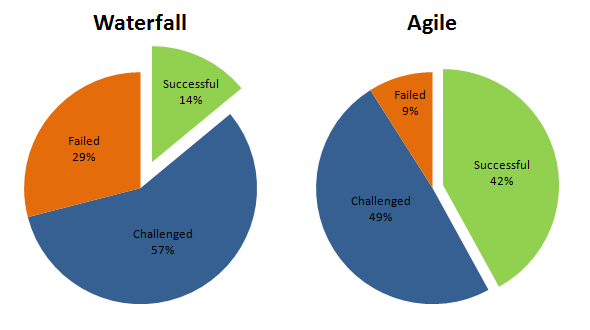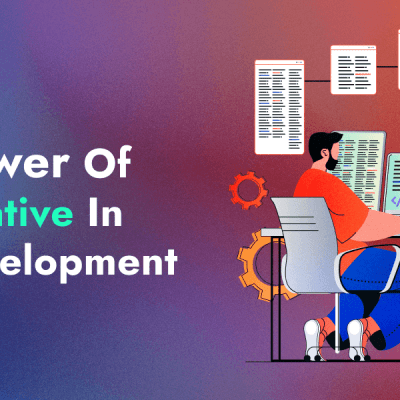If you are even a bit related to the app world, you will have pondered on this heated subject. One side you have the antiquated or rather say tried and tested method waterfall. Here entire development phase is undertaken according to the linear series of events from the conception to the production. On the other side, you have the Agile methodology which is a newer, team focused method describing lean development. So, let’s explore what’s the basic difference between waterfall and agile, what are their pros and cons and which approach should be adopted when.

Waterfall Mobile App Method VS Agile Mobile App Development Method
1) Waterfall Method for App Development
Tradition method where the development process is bifurcated into various stages which must go sequence wise. This is quite visible from the name itself. Just like the waterfall can’t change its direction, the development process can also can’t go back, once the stage is accomplished. You can only work downstream in the entire mobile application development process and have to complete the entire process that way. There can be a generic review at the end but till then you can’t go at the top stage. Here are the stages of the waterfall which might be different according to the different enterprises. Here is a generic method:
Conception: The prime step of any app development process is the idea generation, have cost analysis and conclude what the project is going to be all about.
Hiring resources: When the idea gets finalized, the second step is to hire resources. Hire the project manager, designer, developer, SEO and other required team members. Define the scope and objectives of the project.
Practicality test: Have a backup check and evaluate whether the project is practically implementable or not.
Design: This stage includes mockups, wireframing and storyboards. Designers show the first phase of what the app is going to look like.
Coding: Based on the flowcharts and wireframing of the app, the developers start coding the app and make the app ready.
Testing: After the app is entirely developed, that’s when the testing starts. The smooth functioning of the app is checked and bugs are resolved if any.
Launch: If the app is perfect then, it is finally launched in the App store.
Maintenance: Post-launch maintenance and changes are made based on the feedback of the user. New features can be added or the old one can be modified.
Pros
Fixed project completion date: The nature of waterfall method is fixed and always goes with the flow. This makes making cost estimation easy and also giving a fixed date for app submission. The method is quite rigid and not flexible.
Adequately documented: This methodology will need documentation of each of the phase of the app development. This will make it give an exact idea of the past work and a future path for the new projects.
Direct communication channel: Documents are fixed, deadlines are decided which makes everything works in flow and updating the clients can be precise. Clients can be clear about their needs and company can be clear on what they can give.
Learning process eased up: Waterfall method is static and it doesn’t change time and again. Developers just need to learn it once and implement it again and again.
Cons
Rigid: Well, every process is fixed here which make this process stubborn. The disability to handle change is one of the biggest setbacks. Testing also begins way too much late and hence if you find users are not liking the app., it would rather be too late to make alterations.
Testing ignored: Keeping testing for the end can prove to be an extremely risky thing. Generally, at this phase, the rush of the launching the app is on the head. This can lead to poor testing and an app launch full of bugs.
Slow paced app delivery: There is a fixed date of completion of every stage and even when the phase can be completed early, it will be completed on its desired date only. This will slow down the app delivery process.
2) Agile method for App Development
This method doesn’t do all the planning up front, instead, it follows an iterative approach. This methodology focuses on lean app development and developing minimum viable products in a pre-defined time frame while making improvement in each of the iterations. The basic focus of agile methodology is constant changes, teamwork, and alterations based on the constant user feedback. Here’s a list of some of the other types of implementations used by the mobile app development company:
1) Kanban
2) Scrum
3) Adaptive system development
4) Feature-driven development
5) Extreme programming
Pros
Prompt user feedback: The best part of this method is that you are building anything that the user doesn’t want or like. There is immediate user feedback and the app is changed accordingly. You will get a wide range of user to market to market your app.
Teamwork: The basic need of this method is constant communication and plenty of face to face interactive sessions. This will eradicate chances of making errors and out-bursting with a faulty app.
Quick development: Unlike waterflow method, this method is quick as it is bifurcated into various iterations. The makes the development process real fast and launch can be on the go.
Test-based development: As the development process has various iterations, each of the iteration can be tested separately and yes not in the end. A highly secure app can be developed with this method.
Cons
Documentation not a priority: Well, the team basically so much keen to develop a quality proof app and launch it promptly. Well, that’s a good thing but many times documentation remains aside due to this. There should be a proper balance between the coding and the documentation.
Skill-based teams: Here the work is divided and there is no superior managing everyone’s work. If each team member is self-disciplined and expert in their work, good. If not, the app can really get screwed.
Management issues: Well, with the speed of app launch and flexibility, there also accompanies flaws of irresponsible management. Due to extreme flexibility, chances are their work can delay and so can be the deadline.
Time-consuming: The work of agile methodology depends on the teamwork. This means each team should be in sync with each other and work collaboratively. Communication everything and keeping everyone on the same page can be time-consuming.
When to choose waterfall method?
When you are assured of what you actually want and you have determined objectives which are not going to flatter, the waterfall is the right choice to opt for.
When to choose the Agile method?
When you are at the stage of developing something intuitive and experimental which needs alterations time and again, you know the agile method is the correct alternative to drive your way towards.




